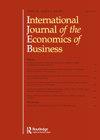Unpacking the Inverted U-shape between Regional AI and Business Performance
IF 0.9
Q3 BUSINESS
International Journal of the Economics of Business
Pub Date : 2023-10-28
DOI:10.1080/13571516.2023.2271755
引用次数: 0
Abstract
AbstractThis study examines how regional artificial intelligence (AI) influences firms’ business performance from the viewpoint of economic geography. We employ the instrumental variable method to analyze 3633 American listed companies. We find the “regional AI and business performance” relationship appears in an inverted U-shape. By applying the plausible instrumental variable method, our robustness check suggests that our findings are reliable. Theoretically, our paper enriches current regional AI studies with firm-level evidence; practically, our paper sheds light on how to make firm location decisions in the AI era.Keywords: Artificial intelligencefirm performancereturn on equityAmericaJEL CLASSIFICATION CODES: R11L10 Disclosure statementNo potential conflict of interest was reported by the author(s).Notes1 According to preliminary math using the equation: y = β0+β1X + β2X2, when β2 is significant, then the (inverted) U-shape exists. β0 and β1 can change the position of the (inverted) U-shape in the coordinate axis, but it is β2 that determines the (inverted) U-shape. Therefore, “β1 is insignificant but β2 is significant” never means that the (inverted) U-shape does NOT exist or means that it is an increasing (or decreasing) return.2 We would like to thank our two anonymous reviewers for bringing this to our attention.Additional informationFundingThis paper is financed by the Humanity and Social Science Foundation (grant number: 22YJCZH117), the National Social Science Funds of China (grant number: 22CJL013) and the Innovative Team Project of Guangdong Universities (grant number: 2019WCXTD008).解开区域人工智能与企业绩效之间的倒u型关系
摘要本文从经济地理学的角度考察了区域人工智能对企业经营绩效的影响。本文采用工具变量法对美国3633家上市公司进行了分析。我们发现“区域人工智能与企业绩效”的关系呈倒u型。通过应用似是而非的工具变量方法,我们的稳健性检验表明我们的发现是可靠的。从理论上讲,我们的论文用企业层面的证据丰富了当前的区域人工智能研究;实际上,我们的论文揭示了如何在人工智能时代做出企业选址决策。关键词:人工智能公司绩效股票回报美国证券交易所分类代码:R11L10披露声明作者未报告潜在利益冲突。注1根据方程y = β0+β1X + β2X2的初步数学计算,当β2显著时,则存在(倒)u型。β0和β1可以改变(倒)u形在坐标轴上的位置,但决定(倒)u形的是β2。因此,“β1不显著,而β2显著”并不意味着(倒)u型不存在,也不意味着收益是递增的(或递减的)我们要感谢两位匿名评论者让我们注意到这一点。本文由人文社会科学基金(批准号:22YJCZH117)、国家社会科学基金(批准号:22CJL013)和广东高校创新团队项目(批准号:2019WCXTD008)资助。
本文章由计算机程序翻译,如有差异,请以英文原文为准。
求助全文
约1分钟内获得全文
求助全文
来源期刊
CiteScore
2.60
自引率
8.30%
发文量
9
期刊介绍:
International Journal of the Economics of Business presents original, peer reviewed research in economics that is clearly applicable to business or related public policy problems or issues. The term "business" is used in its widest sense to encompass both public and private sector—governmental, private non-profit and cooperative organizations, as well as profit-seeking enterprises. International Journal of the Economics of Business carries papers relating to three main spheres: The organization—to analyse and aid decision making and the internal organization of the business; The industry—to analyse how businesses interact and evolve within and across industries.

 求助内容:
求助内容: 应助结果提醒方式:
应助结果提醒方式:


